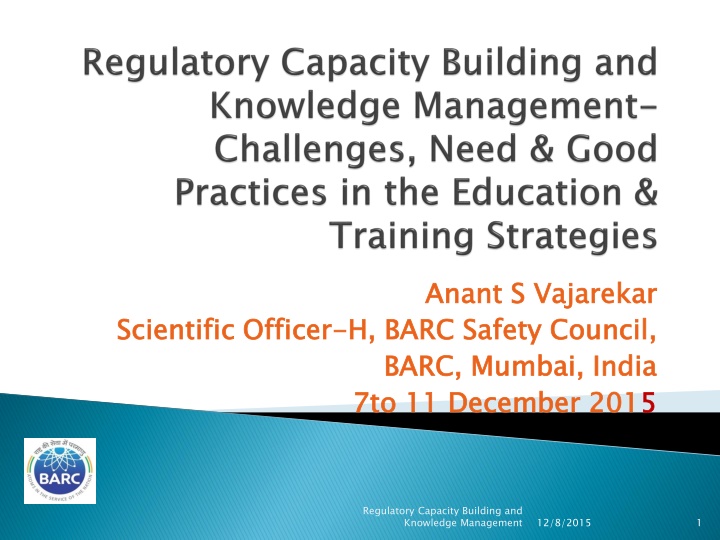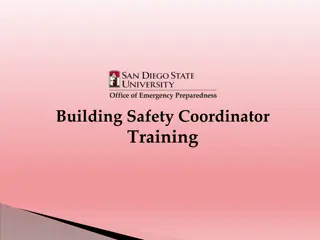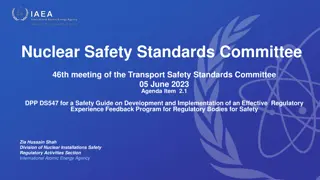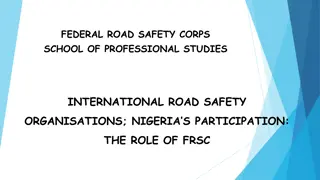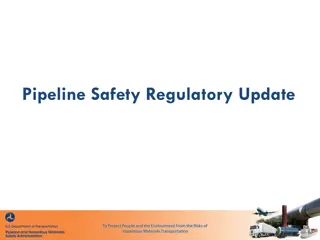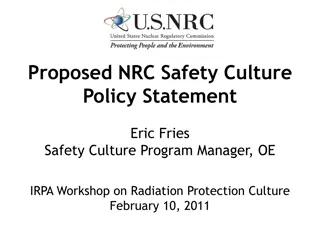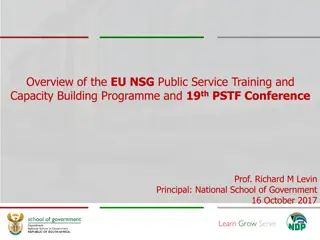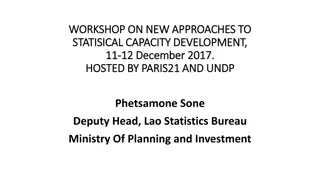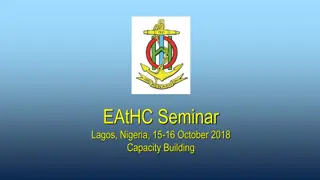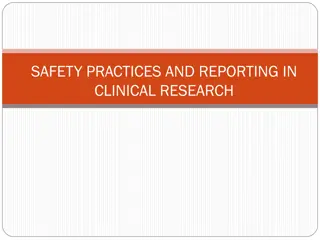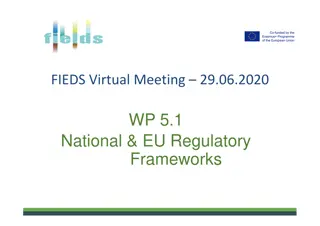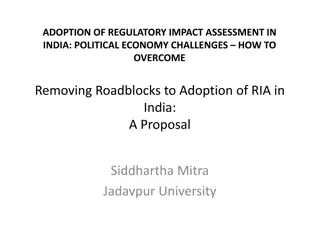Regulatory Capacity Building for Safety Management Organizations
A regulatory body plays a crucial role in promoting effective safety management within organizations by ensuring self-assessment, correction, and adherence to national laws. Regulatory capacity depends on authority, scope, infrastructure, leadership, and more. It is essential to have clear goals, motivated officials, and proper knowledge management for successful regulatory activities.
Download Presentation

Please find below an Image/Link to download the presentation.
The content on the website is provided AS IS for your information and personal use only. It may not be sold, licensed, or shared on other websites without obtaining consent from the author.If you encounter any issues during the download, it is possible that the publisher has removed the file from their server.
You are allowed to download the files provided on this website for personal or commercial use, subject to the condition that they are used lawfully. All files are the property of their respective owners.
The content on the website is provided AS IS for your information and personal use only. It may not be sold, licensed, or shared on other websites without obtaining consent from the author.
E N D
Presentation Transcript
Anant S Vajarekar H, BARC Safety Council, BARC, Mumbai, India 7to 11 December 201 Anant S Vajarekar Scientific Officer Scientific Officer- -H, BARC Safety Council, BARC, Mumbai, India 7to 11 December 2015 5 Regulatory Capacity Building and Knowledge Management 1 12/8/2015
A regulatory body promotes an effective safety management organizations by ensuring that there is self assessment and correction (self regulation) and avoids acting in a manner that diminishes the responsibility to safety of the organization. system in the Safety Responsibility Facility Advise Regulator Regulatory Capacity Building and Knowledge Management 2 12/8/2015
Regulatory capacity of any organization depends on: Authority statutory support through national laws and rules Scope Infrastructure Independence Goals and objectives Leadership Motivation: highly self motivated Organizational Structure domain of regulation Roles and responsibilities Enforcement Image Integration of Safety and Security Knowledge Management battery. Training & Seminars Authority: of the Regulatory body should be reinforced by Scope: should be clearly demarcated Infrastructure: should be adequate Independence : functional and financial Goals and objectives: should be clearly defined. Leadership: main driving force Motivation: officials involved in regulatory activities should be Organizational Structure: should build the teams specific to their Roles and responsibilities: of the regulators should be defined Enforcement: of the guidelines should be prime job. Image : Regulatory Activities are productive. Integration of Safety and Security: should be done meticulously. Knowledge Management: is like storage of electricity in the Training & Seminars: should be conducted on regular basis. Regulatory Capacity Building and Knowledge Management 3 12/8/2015
Regulatory body should have authority through the national laws and rules In India, Regulatory bodies are empowered by the Gazette notification of the national Government Regulatory Activities related to nuclear and radiological facilities are governed by following national laws and rules: Atomic Energy Act 1962 Safe Disposal of Radioactive Waste Rules 1987 Atomic Energy Factory Rules 1996 Radiation Protection Rules 2004 Regulatory Body should have authority to pick up the experts from the fields of interest. Regulatory Capacity Building and Knowledge Management 4 12/8/2015
Scope of regulatory bodies should be clearly demarcated in writing. Need of it is felt more when there are more than one regulatory body in a country It avoids embarrassment of not only facility but also of regulatory body. In India, there are two regulatory bodies 1. Atomic Energy Regulatory Board ( international safeguards 2. BARC Safety Council ( facilities involved in research and development programme of nuclear energy Atomic Energy Regulatory Board (AERB Regulates the nuclear facilities under AERB): ): BARC Safety Council (BSC BSC) ): Regulates the the Regulatory Capacity Building and Knowledge Management 5 12/8/2015
Safety and security aspects are intimately linked and many of the measures designed to address safety would also address security. Nuclear security and nuclear safety have in common the aim of protecting persons, property, society and the environment. Security measures and safety measures have to be designed and implemented in an integrated manner to develop synergy between these two areas and also in a way that security measures do not compromise safety and safety measures do not compromise security. Nuclear security together with nuclear safety and applicable safeguards is essential for enjoying many benefits of nuclear material in industrial, agricultural, and medical applications, nuclear energy, and many other areas. Regulatory Capacity Building and Knowledge Management 6 12/8/2015
Most of the time there is inflow of the information to Regulatory body. The knowledge gained should be properly categorized, coded and stored in an easily retrievable manner so that it can be channelized for the benefit of nuclear industry. For achieving perfection in regulation, knowledge management is the important tool. Collective Knowledge is very useful for review and renewal as per latest internal codes, guides and standards. KM helps in ensuring the compliance by various facilities. Regulatory Capacity Building and Knowledge Management 7 12/8/2015
Availability of Manpower for regulatory jobs Regulatory work requires man power which should be experienced in the respective field to be regulated. The facilities are reluctant to release their experienced hands for the regulatory job who will be regulating them in future. Motivation regulatory jobs are those persons who have been sidelined from the main stream and as a part of appeasement these persons are redeployed in regulatory domains. Structured Education & Training having a training school for providing pre-induction training to the engineers and scientists but it doesn t have required courses to cover regulatory aspects. Image of Regulatory Body regulatory job as non-productive and do not provide the importance it deserves. Regulatory Capacity Building and Availability of Manpower for regulatory jobs: Motivation: Normally the manpower released for the Structured Education & Training: Though BARC is Image of Regulatory Body: Some people consider Knowledge Management 8 12/8/2015
India has two regulatory bodies, one (AERB) for the facilities involved in nuclear power production and associated services another (BSC) for the facilities involved in research and development programme of nuclear energy. BARC Safety council which covers the later part hand picks the experienced professionals depending on the requirements of the regulatory body. Pre-induction training of six months is provided in various other facilities to improve upon their versatility. On the job training is also provided by associating the new joinees with experienced and seasoned regulatory professionals. Professionals involved in regulatory jobs are also sent to participate in the training seminars conducted by AERB, IAEA and other organizations. Regulatory Capacity Building and Knowledge Management 9 12/8/2015
Exposure of Regulatory Work in Early stage a serious need of exposure of regulatory work for the trainee officials in the early stage of their education and training. Part of Undergraduate Curriculum need of education in the field of Industrial Safety and a course should be devised for all undergraduate courses covering basics. Self Regulation importance of safety and it should be more of their responsibility to operate the plants in safe and secured manner without presence of any regulatory guidelines. Safety & Security by Design regulatory awareness and hostile global scenario, designers have to understand their increased responsibility to consider the aspects of safety and security in design stage it self. Exposure of Regulatory Work in Early stage : There is Part of Undergraduate Curriculum: There is a strong Self Regulation: Facilities should understand the Safety & Security by Design: With the increase in Regulatory Capacity Building and Knowledge Management 10 12/8/2015
Regular training and seminars are very effective mode of knowledge sharing and updating. T & S help regulators to keep themselves abreast of the latest regulatory developments, codes, guides and standards. T&S not only cause introspection among the regulators but also stimulate and motivate them to attain new heights of perfection. Participation in the seminar should be interactive, reciprocative and contributive. Learning through seminars should be disseminated to the peers and colleagues for collective capacity building. Regulatory Capacity Building and Knowledge Management 11 12/8/2015
"that assembly of characteristics and attitudes in organizations and individuals which establishes that, as an overriding priority, nuclear installation safety issues receive the attention warranted by their significance" Regulatory Capacity Building and Knowledge Management 12 12/8/2015
Organization set up with well defined responsibilities and team spirit QA Plan Operation/Maintenance procedures surveillance plan Documentation - at the various stages e.g. designing, construction, operation Incidence reporting- timely and accurate report in line with INES grades Record keeping - records should be graded and retrievable Industrial Licenses Waste Management - Policy and records Recruitment, training and retraining policy Regulatory inspection/ audit details Radiological safety measures Emergency drill / measures Design change/ up gradation Housekeeping and general hygiene etc Regulatory Capacity Building and Knowledge Management 13 12/8/2015
Global Centre for Nuclear Energy Partnership (GCNEP) Regulatory Capacity Building and Knowledge Management 14 12/8/2015
FIVE(5) Schools FIVE(5) Schools School of Advanced Nuclear Energy System Studies (SANESS) School of Radiological Safety Studies (SRSS) School for Studies on Applications of Radioisotopes and Radiation Technologies (SSARRT) School of Nuclear Material Characterization Studies (SNMCS) School of Nuclear Security Studies (SNSS) Regulatory Capacity Building and Knowledge Management 15 12/8/2015
School of Nuclear Security Studies RTC on Physical Protection of Nuclear Material and Nuclear Facilities (2003, 2004, 2005, 2007, 2009) RTC on Physical Protection of Radioactive Sources (2006) RTC on PP of NF against Sabotage, Assessing Vulnerabilities and Identifying Vital Areas (2011) National Course Physical Protection against Sabotage and Vital Area Identification (2010) Total number trained 204 (Foreign 115, Indian 89) Total number of Countries (participants) 16 [Bangladesh, China, Egypt, Indonesia, Kazakhstan, Kyrgyzstan, Malaysia, Mongolia, Myanmar, Phillipine, Rep. of Korea, Saudi Arabia Sri Lanka, Thailand, UAE, Vietnam] Total number of Faculties 94 (Foreign 34, Indian 60) Faculties from 10 Countries Australia, Czech Rep., France, Indonesia, Lithuania, Lithuania, Netherland, Russia, Spain, USA] Regulatory Capacity Building and Knowledge Management 16 12/8/2015
Nuclear Security Member ADSEC, IAEA Member, NSGC, IAEA Technical Experts in Various Standards and Guides Committees Technical Experts in development of various Course Curriculum and Corse material on Nuclear safety and Nuclear security Faculty in International and regional training Courses as faculty Technical expert in International Advisory Missions Regulatory Capacity Building and Knowledge Management 17 12/8/2015
For an accident free track record of any organization, credit goes to the regulatory body. Though regulatory body is always blamed for nagging the facilities but regulatory body should be never disheartened by such blames and do justice to their roles and responsibilities. Regulators should have very matured and graded approach to handle the critical issues. Provisions should be in place for training and honing the skills of regulators on regular basis. Regulators should always have an attitude to improve upon themselves and keep themselves abreast of the latest regulatory developments, codes, guides and standards. Regulatory Capacity Building and Knowledge Management 18 12/8/2015
Thank You Regulatory Capacity Building and Knowledge Management 19 12/8/2015
ATOMIC ENERGY COMMISSION ATOMIC ENERGY COMMISSION ATOMIC ENERGY REGULATORY BOARD DEPARTMENT OF ATOMIC ENERGY DAE Science Research Council SERVICE PUBLIC SECTOR UNDERTAKINGS INDUSTRIAL FACILITIES R&D centers ORGANISATIONS Heavy Water Board, Mumbai DPS, Mumbai NPCIL., Mumbai BARC, Mumbai IGCAR Kalpakkam DCSEM, Mumbai IREL, Mumbai Nuclear Fuel Complex, Hyderabad RRCAT, Indore UCIL, Jaduguda GSO, Kalpakkam VECC, Kolkata ECIL, Hyderabad BRIT, Mumbai AMDER, Hyderabad BHAVANI, Kalpakkam GCNEP, Haryana Back IOP TIFR, Mumbai BRNS, Mumbai Bhubaneswar IMSC, Chennai HBNI, Mumbai NBHM, Mumbai HRI, Allahabad IPR, Ahmedabad TMC, Mumbai NISER, AEES, Mumbai SINP, Kolkata Bhubaneshwar 20 12/8/2015 Regulatory Capacity Building and Knowledge Management
Director, BARC Director, BARC (Facility Owner; Appellate and Competent Authority) (Facility Owner; Appellate and Competent Authority) Back BARC Safety Council (BSC BARC Safety Council (BSC) ) Safety Committees for Specific Facilities Safety Secretariat [Technical & Administrative support] Safety Secretariat [Technical & Administrative support] Physical Protection System Review Committee (PPSRC) Committee to Review Application for Authorisation of Safe Disposal of Radioactive Waste (CRAASDRW) Design Safety Review Committee (DSRC) Design Safety Review Committee (DSRC) Operating Plants Safety Review Committee (OPSRC) Operating Plants Safety Review Committee (OPSRC) Conventional & Fire Safety Review Committee (CFSRC) Conventional & Fire Safety Review Committee (CFSRC) Safety Review Committee for New Construction (SRCNC) Plant/Unit Level Safety Committees Plant/Unit Level Safety Committees Working Groups [Detailed review of design safety] Working Groups [Detailed review of design safety] [Operational Safety Review; Compliance with statutory requirements; Internal Inspection] [Operational Safety Review; Compliance with statutory requirements; Internal Inspection] 21 12/8/2015 Regulatory Capacity Building and Knowledge Management
